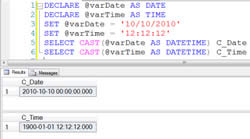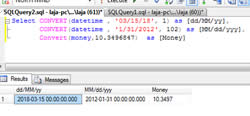Difference between CAST and CONVERT
Key Difference: CAST and CONVERT are two functions that are part of the SQL server. Both of these functions allow the user to convert an expression from one format to another.
CAST and CONVERT are two functions that are part of the SQL server, which is a relational database management system (RDBMS). There are various different types of RDBMS that are offered by many different companies including Microsoft, Sybase, MySQL, etc. These two functions are part of the Microsoft SQL server and play a part in the conversion of data. Both these functions are used to convert data from one format to another, but are different from each other in a few ways.
The SQL (Structured Query Language) is a relational database management system from Microsoft. The main function of the software is to store and retrieve data that is requested by other software applications, no matter where they are running. The coding for the original Microsoft SQL server was initially designed and sold by Sybase SQL Server, before Microsoft entered the database management market. In order to create SQL Server 1.0 for OS/2, Microsoft teamed up with Sybase and Ashton-Tate in 1989 and wrote the code for the first version. By the 4.21 version for NT had been released, Microsoft had dissolved its partnership with Sybase and that particular version was released and sold only under the Microsoft name.
Firstly, there are two ways that data is converted in the SQL server, implicit and explicit. Implicit conversion includes that the server automatically converts the data without requiring the user to input any external data or coding. However, much of the data falls in the explicit section, where the server requires the user to specify how they want the data to be converted. If the user does not specify how the data should be converted, the system will try to convert the data implicitly.
 The CAST function lets the user convert an expression from one format to another, such as a value retrieved from a column or variable, to a different data type. Robert Sheldon of simple-talk.com provides the basic syntax of the CAST function as “CAST (expression AS data_type [ (length ) ] )”. In this function the user specify the CAST keyword and then the necessary arguments in the parenthesis. The first argument is the expression that the user wants to convert, followed by the AS keyword and then the expression that the user wants to covert to. When required, the user can also specify a length for the expression. One important issue with CAST is when converting any value to a binary data type of a different length than the original, the SQL Server pads or truncates the data on the right side of the value, whereas for any other data types it pads or truncates the data to the left side.
The CAST function lets the user convert an expression from one format to another, such as a value retrieved from a column or variable, to a different data type. Robert Sheldon of simple-talk.com provides the basic syntax of the CAST function as “CAST (expression AS data_type [ (length ) ] )”. In this function the user specify the CAST keyword and then the necessary arguments in the parenthesis. The first argument is the expression that the user wants to convert, followed by the AS keyword and then the expression that the user wants to covert to. When required, the user can also specify a length for the expression. One important issue with CAST is when converting any value to a binary data type of a different length than the original, the SQL Server pads or truncates the data on the right side of the value, whereas for any other data types it pads or truncates the data to the left side.
 The CONVERT function is also a similar function to CAST function, which allows the user to convert an expression from one data format to another. The syntax of the CONVERT function is ‘CONVERT (data_type [ (length ) ] ,expression [ ,style ] )’ The syntax elements of the CONVERT function are in a different order from the CAST function but are almost the same. The user must state the data type, the length of the data type and the expression that needs to be converted. The CONVERT function does not require the AS keyword. An additional feature of the CONVERT function is the style argument, which is an integer that represents a predefined format. The style is specific to the data type that is being converted.
The CONVERT function is also a similar function to CAST function, which allows the user to convert an expression from one data format to another. The syntax of the CONVERT function is ‘CONVERT (data_type [ (length ) ] ,expression [ ,style ] )’ The syntax elements of the CONVERT function are in a different order from the CAST function but are almost the same. The user must state the data type, the length of the data type and the expression that needs to be converted. The CONVERT function does not require the AS keyword. An additional feature of the CONVERT function is the style argument, which is an integer that represents a predefined format. The style is specific to the data type that is being converted.
While both the functions perform the same objective, conversion of data, there are a few differences between the two. In some conversions the CAST function offers faster and easier performance or vice-versa. The CONVERT function is better when trying to convert date and time values, fractional numbers, and monetary signifiers. However, the CAST function is of ANSI standard and is more portable compared to CONVERT function and can be used for other database applications without having the user to change much. CAST is also handier when it comes to converting decimals and numeric values, as the function can keep the decimals from the original expressions. Many experts suggest using CAST and CONVERT together, while using CAST first for conversion and the CONVERT for other tasks that are much better in the CONVERT function.
Image Courtesy: pinaldave.com, c-sharpcorner.com









Add new comment